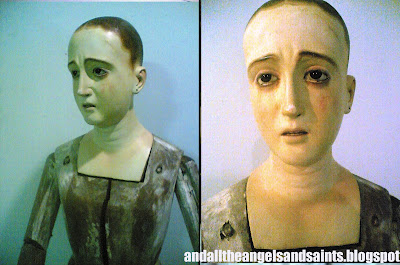 |
| STA, MARIA MAGDALENA, RESTORED 2005 |
The circumstance of how this beautiful Sta. Maria Magdalena image was delivered to me was one for the books. I had been working with a Bulacan dealer for sometime, when he called to say that there was an antique santa in the market available, but I had to decide fast whether to get it or not. To make my decision faster, he offered to bring it to me in Makati, where I lived and worked.
 |
| MAGDALENA, in its original state, when acquired |
Intrigued, I told him to pass by for me by lunchtime, hitch with him in his van, go home together to my nearby studio where I can better check out the santa. Some 2 hours later, he was on his cellphone to tell me of his arrival at my office building. I hastily rushed down the elevator from my 23rd floor office, got out of the main door---and there, seated at the groundfloor Starbucks Café was my dealer, next to an old, naked, wigless santa, and which has started to attract the stares of the café patrons, building tenants, businessmen, visitors, and passersby! In a loud voice, he said: “Eto na ang Magdalena mo, boss…what do you think?”
 |
| MAGDALENA, with a wan and white complexion. |
“I think you need to put back the santa in your van NOW!”, I muttered under my breath, while turning red with embarrassment. Just as a crowd had begun to gather around the santa, the dealer grabbed the wooden figure, stowed it in the van, and sped away with me to my place, just 5 minutes away.
 |
| MAGDALENA'S HEAD, before and after re-encarnacion |
I’ve never been so stressed at the thought of the commotion we caused at that café. But all that dissipated when, in the privacy of the closed van, I took a closer look at the penitent saint.
 |
| STA. MARIA MAGDALENA, under restoration |
Even in its state—paint gone pale and peeling, a vertical crack running down the body, shaky base, plus the usual dings, nicks and scratches—this Sta. Magdalena was a real beauty, with a long face face slightly frowning in restrained grief. Her mouth was slightly open, curled downward in sorrow, showing teeth. The slightly long neck featured 3 shallowly-carved neck folds that almost looked like a 3-strand necklace.
 |
| STA. MAGDALENA, under restoration |
On the other hand, her ghostly white hands and slender fingers, and her bare feet were well-carved and defined. There was the slightest hint of plumpness in her body, characteristic of old female santas. This processional image was not exactly tall, only 52 inches, including the base.
 |
| REPAINTING THE PENITENT SAINT |
The dealer and I struck a deal, wrote him a check, and Sta. Maria Magdalena was mine to keep. But it didn’t stay long with me either, for just a scant week after, I delivered the Magdalena to the atelier of Mr. Francisco “Kiko” Vecin, Makati’s eminent collector and santo restorer. His workshop was just across my street, near the Makati City Hall, and the schedule for its restoration was drawn up in no time at all.
 |
| THE SAINT AND HER BLONDE-BROWN LONG LOCKS |
As the santa was complete, I thought restoring it would be a breeze. Other than the crack on the body, no major repairs were really necessary. What took long was the repainting of the santa that took some 3 months to finish. A friend of mine suggested that I stick to the original paleface kind of encarna, commonly seen in old Semana Santa images. I opted for a more natural complexion that is more Filipino, rather than the fair, pinkish Caucasian type.
 |
| STA. MAGDALENA, CROWNED |
Mang Kiko commissioned veteran encarnador Eddie Mabaquiao Sr. to handle the repainting, which took forever to do. But the wait was all worth it, as the santa’s expression came real and alive with his brush. The magnifical restoration of Sta. Maria Magdalena was completed in late 2005.
 |
| VESTMENT BY LOPEZ ATELIER |
Even long before it was finished, a member of our local pastoral council had saved a place for me 2006 Holy Week procession. The reservation, however, was not for a Magdalena, as the town already had one—but for broom-wielding Sta. Maria Jacobe. The idea was to transform this Magdalena into a Jacobe, by having her hold a broom—which was very much possible with the grasping position of her fingers.
 |
| OLD EMBROIDERY RECOVERED AND USED FOR MAGDALENA'S VETSMENT |
This
threw me into panic, as I had not really planned on having vestments and metal
accessories made just yet. Dr. Raffy Lopez came to the rescue by quickly
making a light blue half-cape and a matching light fuschia tunic decorated with
old gold embroidery. I designed a pukpok broom handle executed in plated brass
by Jeric Canlas, inserted with tambo reeds. A new brass crown that
I had been keeping went to the head of the santa, which looked obviously
bigger. With that the primera salida of this Sta. Maria Magdalena finally
took place in 2006—in the guise of Sta.
Maria Jacobe! I soon had ambivalent feelings about that practice.
 |
| PRIMERA SALIDA, as Sta, Maria Jacobe, 2006 |
That was the first and last time this antique santa came out, eventually replaced by my in-law family’s antique Jacobe. But when a second Magdalena I owned suffered a similar fate, I have vowed not to allow these “conversions” to happen again.
In one
corner of our covered porch today stands a glass case, in which the cloth-covered
antique image of Sta. Maria Magdalena reposes. It has not been seen
since 2006, and I intend to keep it that way. It is very much in keeping with a
penitent saint who spent part of her life as a hermit in a cave on a desert—away
from prying eyes. Her life continues to give us an example of how no person is
beyond the saving grace of God, so—by the same token, no broken santo should be left unsaved too.
.jpg) |
| STA. MARIA MAGDALENA, Castro Family |










































